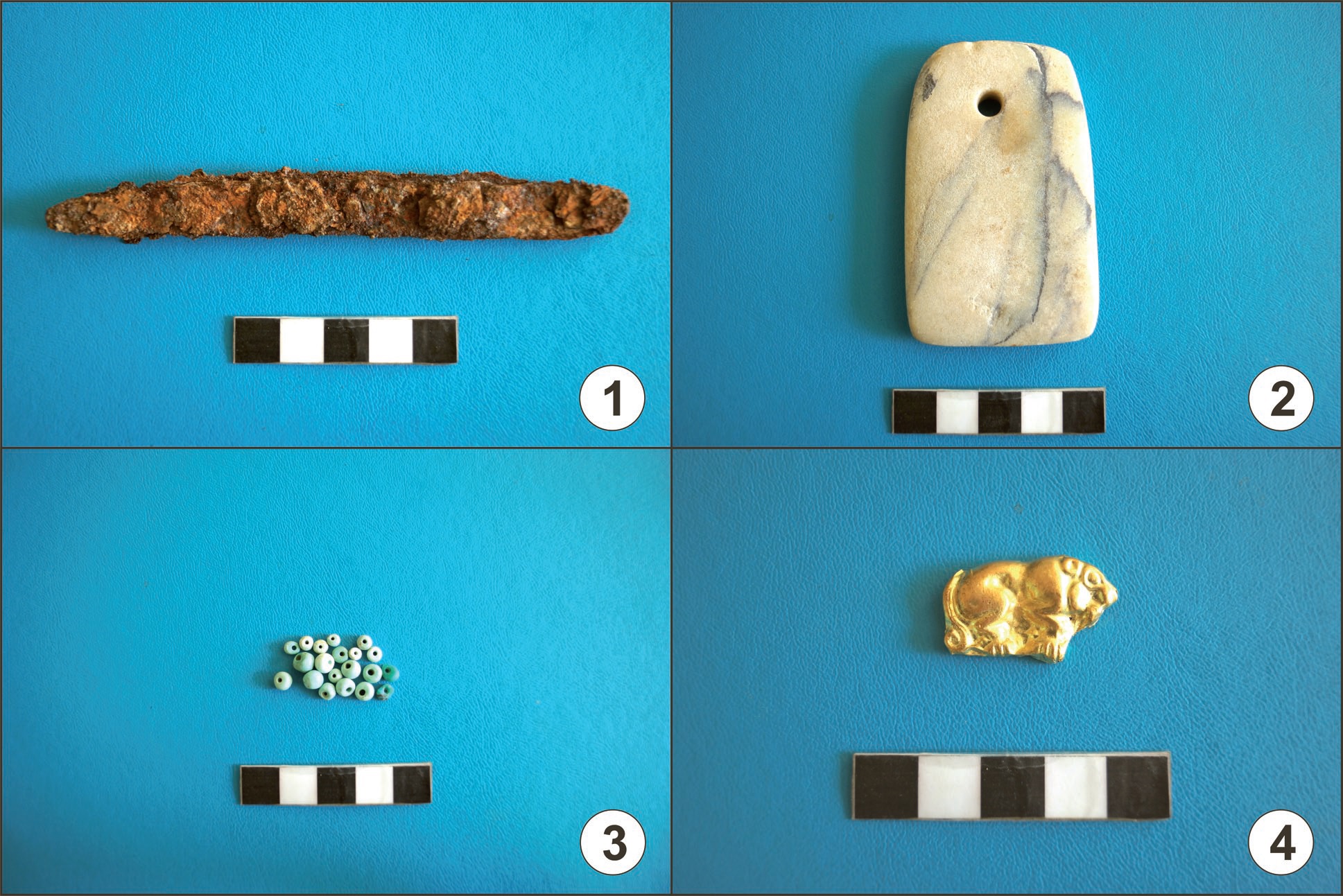A child's burial and new data of radiocarbon dating of monuments of the early Iron Age in Сentral Kazakhstan
DOI:
https://doi.org/10.52967/akz2022.1.15.98.109Keywords:
archaeology, Central Kazakhstan, early Iron Age, Tasmola culture, radiocarbon datingAbstract
The article discusses the results of fieldwork on the early Iron Age burial mound, investigated in the Aktogay district of the Karagandy region. It had an uncovered stone mound, under which the burial of a 4–5 year-old child laid on his back in an elongated position was recorded, accompanied by stone beads, an iron knife, a stone whetstone and a gold overlay. The Tasmola cultural identity of the excavated complex is indicated, first of all, by the zoomorphic overlay, on which the profile of a feline predator was depicted, which is characteristic of the Scythian-Saka animal style. In view of the absence of more specific chronological reference points, the investigated burial should be dated within a wide framework of the 8th–5th centuries BC. The results of radiocarbon dating of the burials of the Tasmola culture in the barrows of Borly and Senkibay-2 are also introduced into scientific circulation, which to a certain extent corrected the preliminary dating of these complexes, based on the method of typological analogies. According to new data, firstly, the materials of the Senkibay-2 burial ground should be somewhat dated to the 9th – beginning of the 8th century BC; secondly, the burial of the Borly mound should be dated to a slightly wider time range – the middle of the 8th – middle of the 6th century BC.
References
Beisenov, A. Z. 2015. In: Istoricheskaya i sotsialnaya obrazovatelnaya mysl (Historical and social educational thought), vol. 7, no. 6, 22-31 (in Russian).
Beisenov, A. Z. 2017. In: Kazahstan v sakskuyu epohu (Kazakhstan in the Saka era). Almaty: A.Kh. Margulan Archaeology Institute, 59-100 (in Russian).
Beisenov, A. Z. 2018a. In: Tishkin, A. A. (ed.). Sovremennye reshenija aktualnyh problem evraziyskoy arheologii (Modern solutions to the actual problems of Eurasian archaeology). Barnaul: Altay State University, 139-149 (in Russian).
Beisenov, A. Z. 2018b. In: Arheologija i davnjaja istorija Ukraini (Archaeology and Early History of Ukraine), 2 (27), 386-396 (in Russian).
Beisenov, A. Z., Bazarbayeva, G. A. 2017. In: Samarskiy nauchnyj vestnik (Samara Scientific Bulletin), vol. 6, no. 1 (18), 89-94 (in Russian).
Beisenov, A. Z., Duisenbay, D. B. 2017. In: Kulikov, F. I. (ed.). Istoriya i kultura narodov Yugo-Zapadnoy Sibiri i sopredelnyh regionov (Kazahstan, Mongolija, Kitaj) (History and culture of the peoples of Southwest Siberia and adjacent regions (Kazakhstan, Mongolia, China)). Gorno-Altaysk: Gorno-Altay State University, 18-25 (in Russian).
Beisenov, A. Z., Kasenalin, A. E. 2018. In: Teorija i praktika arheologicheskih issledovanij (Theory and practice of archaeological research), 4 (24), 85-100 (in Russian).
Beisenov, A. Z., Shashenov, D. T. 2020. In: Nizhnevolzhskij arheologicheskij vestnik (Nizhnevolzhsk Archaeological Bulletin), vol. 19, no. 1, 268-284 (in Russian).
Kadyrbayev, M. K. 1966. In: Margulan, A. Kh., Akishev, K. A., Kadyrbayev, M. K., Orazbayev, A. M. Drevnjaja kultura Centralnogo Kazahstana (Ancient culture of Central Kazakhstan). Alma-Ata: „Nauka“ KazSSR (in Russian).
Kukushkin, I. A., Dmitriev, E. A. 2018. In: Tishkin, A. A. (ed.). Sovremennye reshenija aktualnyh problem evrazijskoj arheologii (Modern solutions to the actual problems of Eurasian archaeology). Barnaul: Altay State University, 2, 173-177 (in Russian).
Kukushkin, I. A., Loman, V. G. 2013. In: Loman, V. G. (ed.). Arheologicheskie issledovanija stepnoy Evrazii (Archaeological research of steppe Eurasia). Karaganda: TENGRI Ltd, 192-195 (in Russian).
Tairov, A. D. 2007. Kochevniki Uralo-Kazahstanskih stepey v VII–VI vv. do n. je (Nomads of the Ural-Kazakh steppes in the 7th–6th centuries BC). Chelyabinsk: South Ural State University (in Russian).
Khabdulina, M. K. 1994. Stepnoe Priishimie v epohu rannego zheleza (Steppe Priishimye in the Early Iron Age). Almaty: “Rakurs” (in Russian).
Chugunov, K. V. 2011. In: Machinskiy, D. A. (ed.). Evropeyskaya Sarmatiya (European Sarmatia). Saint Petersburg: “Nestor-Istorija”, 39-60 (in Russian).
Fazekas, I. Gy., Kosa, F. 1978. Forensic Fetal Osteology. Budapest: Akademiai Kiado (in English).
Jeanty, P. 1983. In Radiology, 147, 601-602 (in English).
Maresh, M. M. 1970. In Human Growth and Development, 157-200 (in English).
Reimer, P. J., Austin, W. E. N., Bard, E., Bayliss et al. 2020. In: Radiocarbon, vol. 62, 4, 725-757 (in English).
Schaefer, M., Black, S., Scheuer, L. 2009. Juvenile Osteology: a laboratory and field manual. Elsevier Inc. (in English).

Downloads
Published
How to Cite
Issue
Section
License
Copyright (c) 2022 Евгений Анатольевич Дмитриев, Алексей Игоревич Кукушкин, Адиль Болатович Макен, Олжас Саятович Шохатаев

This work is licensed under a Creative Commons Attribution-NonCommercial 4.0 International License.






